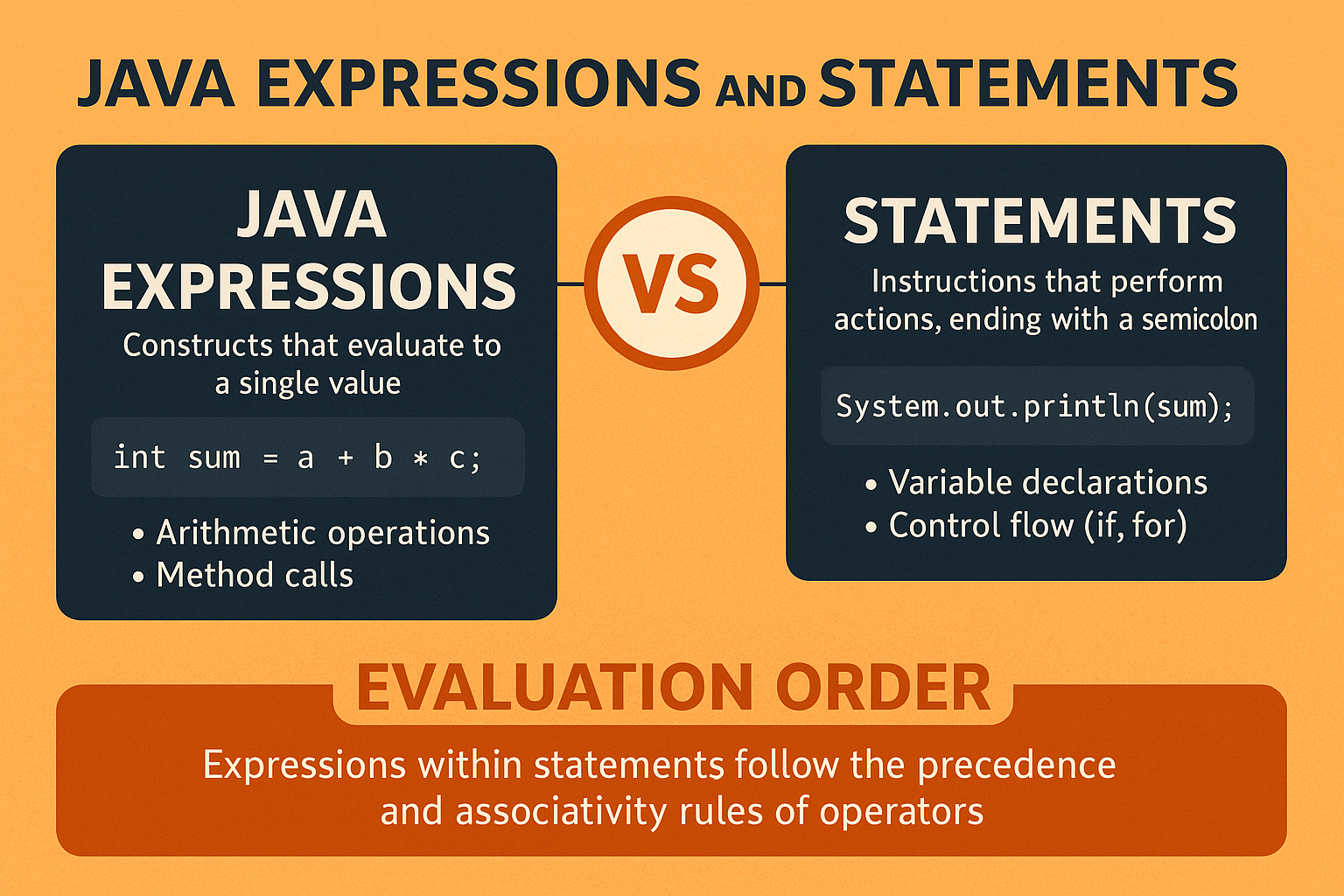Java Expressions and Statements – Understanding the Difference and Evaluation Order
Java programs are made up of building blocks that define logic, perform calculations, and control execution flow. Two key components in this structure are expressions and statements. Understanding their difference and evaluation order is crucial for writing correct and optimized Java code.
🔍 What is a Java Expression?
A Java expression is a combination of variables, operators, literals, and method calls that evaluates to a single value.
✅ Key Points:
- Always produces a value.
- Can be used inside statements.
- Can be nested inside other expressions.
✅ Example:
int result = (5 + 3) * 2; // (5 + 3) * 2 is an expression
boolean isAdult = age >= 18; // age >= 18 is an expression
📌 Expression Types:
- Arithmetic expressions (
a + b) - Boolean expressions (
x > y) - Method call expressions (
Math.max(a, b))
📝 What is a Java Statement?
A Java statement is a complete unit of execution that performs an action.
✅ Key Points:
- May or may not produce a value.
- Always ends with a semicolon (except control flow statements).
- Can contain one or more expressions.
✅ Example:
int a = 10; // Declaration statement
a = a + 5; // Assignment statement
System.out.println(a); // Method call statement
📌 Statement Types:
- Declaration statements
- Assignment statements
- Control flow statements (
if,for,while) - Expression statements
🔄 Difference Between Expressions and Statements
| Feature | Expression | Statement |
|---|---|---|
| Definition | Produces a single value | Performs an action |
Ends with ; |
Not necessarily | Usually ends with a semicolon |
| Usage | Used inside statements | Defines program flow and actions |
| Examples | a + b, x > y |
int a = 5;, if(x > y) {} |
📌 Evaluation Order in Java
Java uses operator precedence and associativity rules to evaluate expressions.
✅ Key Rules:
- Parentheses are evaluated first.
- Multiplication/division before addition/subtraction.
- Left-to-right evaluation for most operators.
- Short-circuit behavior for
&&and||.
✅ Example:
int result = 5 + 3 * 2; // Evaluated as 5 + (3 * 2) = 11
boolean check = (x > 5) && (y++ < 10); // y is incremented only if x > 5 is true
✅ Real-World Use Case
- Expressions: Used in formulas, conditions, and calculations.
- Statements: Used to define program logic and structure.
🚫 Common Mistakes
- Confusing expressions with statements inside control flow:
if(x = 5) { } // ❌ Assignment is an expression but not a valid boolean statement
- Ignoring evaluation order in complex expressions.
💡 Tips & Best Practices
- Keep expressions simple for readability.
- Use parentheses to clarify precedence.
- Avoid side effects (e.g.,
x++inside complex expressions).
🧠 Interview Relevance
-
Q: Can every expression be a statement?
-
A: Not necessarily. Only expressions that perform an action and end with a semicolon are valid statements.
-
Q: What is the evaluation order in Java?
-
A: Determined by operator precedence and left-to-right associativity.
🧩 Java Version Relevance
| Java Version | Feature |
|---|---|
| Java 1.0 | Expressions and statements introduced |
| Java 8+ | Lambda expressions added as new expression type |
✅ Summary
- Expressions evaluate to a value.
- Statements perform an action.
- Understanding evaluation order prevents logic bugs and improves code readability.
